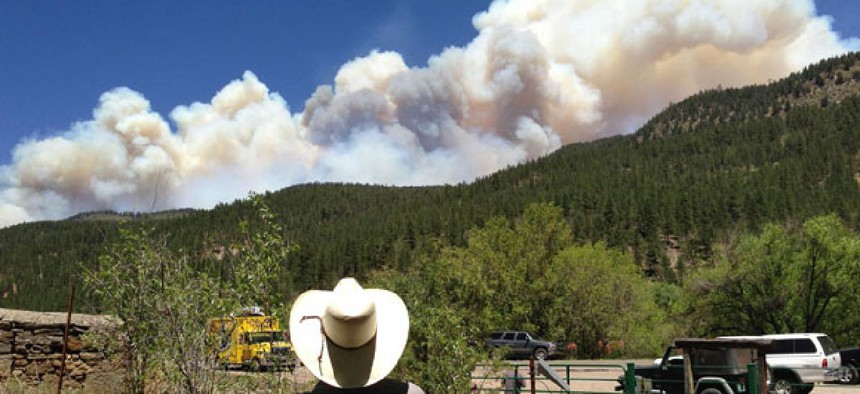Santa Fe Forest Fire Highlights Extreme Danger This Season

Tracy Bennett watches a large plume of smoke rise from a wildfire Friday near Pecos, New Mexico. Barry Massey/AP
Drought and tinder-dry trees fuel 7,990 acre blaze in New Mexico.
Pecos, N.M. – Florentino Gonzales has not returned to his home southeast of Santa Fe since he fled an encroaching forest blaze last Thursday – among the first of many fires likely to char the Southwest this year.
Gonzales, who is confident the two horses he left behind will escape the fire on their own, also has faith in the teams of firefighters led by John Pierson, incident commander for the current fire, named Tress Lagunas after the small settlement of vacation homes where it broke out.
Severe drought, high winds and tinder-dry trees mean “extreme fire conditions” here, Pierson told reporters. These same conditions drove the National Interagency Fire Center’s dismal summer fire outlook. “Above normal significant wildland fire potential is already present across portions of southern and central Arizona and western New Mexico, stretching toward northern New Mexico,” the Boise, Idaho-based center warned. “Through June expect these conditions to push northward and encompass most of Arizona and all of western and northern New Mexico.”
That forecast emphasized the dry timber conditions Pierson faces fighting the Tres Lagunas fire. “Nearly all areas west of the Rocky Mountains, except the far northern reaches, had very low fuel moistures, raising the probability for severe fire activity in the summer,” he said.
The Tres Lagunas fire had grown to 7,990 acres (12.5 square miles) by Monday morning, with only five percent contained and the forecast for fire behavior still rated extreme. During the first two days of the fire, Pierson said, high winds prevented the use of aerial tankers and helicopters carrying buckets of water in sling loads, but the winds then died down, and they dropped 49,000 gallons of water Sunday. Five helicopters remained available if needed.
Pierson said the grunt work of fighting the Tres Lagunas fire falls on hand-crews that dig lines one shovelful at a time, backed up a total of ten bulldozers. The 411 firefighters here include local volunteer fire departments and crews drawn from around the West, such as an elite “hotshots” team from the Zuni Pueblo, 254 miles southwest. The hand-crews work grueling 14 hour days, and after 14 days on the line, they need to stand down, Pierson said.
Firefighting efforts here are concentrated on both ridge lines and canyons on either side of a dead-end paved road (N.M. 63). The topography interferes with point-to-point radio communications, so teams had to install three mountaintop radio repeaters to ensure communications with the fire crews, Pierson said.
Structures threatened by the fire include 134 vacation homes, 10 primary residences and 14 campgrounds, all evacuated last week. New Mexico Gov. Susana Martinez told a press briefing on Saturday that residents will not be permitted to return until the area is safe.
Among the buildings in the Tres Lagunas fire zone is the Perrot Caliente cabin, which was leased and then owned for decades starting in 1928 by J. Robert Oppenheimer, head of the Manhattan Project, which developed the atomic bomb at Los Alamos, 60 miles northwest of here.
The Tres Lagunas incident command team is headquartered on a ranch once owned by 1940s film star Greer Garson and now part of the Pecos National Historic Park.
Gonzales said his family homesteaded here over 100 years ago here, lost property in the Depression and then bought nearby parcels in the 1950s. He said he trusts that Pierson and his crew will defeat the fire and he will return to an untouched house, his free-roaming horses nearby.
NEXT STORY: Airborne iThing Insanity






